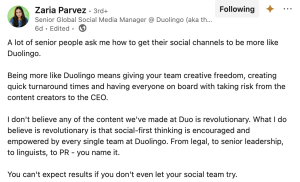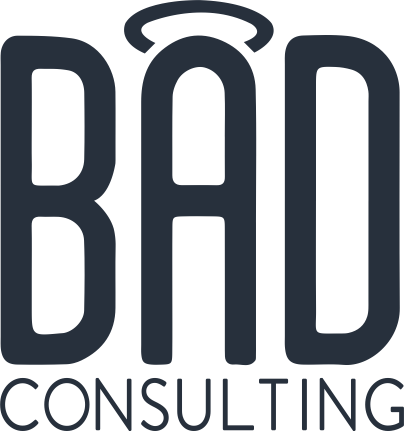 When I saw this post from a Duolingo social media manager, I cheered. Social-first thinking? Having open communication with your social media manager? Empowering your social team? YES. These are all the makings of great social media marketing and will get organizations so much further.
When I saw this post from a Duolingo social media manager, I cheered. Social-first thinking? Having open communication with your social media manager? Empowering your social team? YES. These are all the makings of great social media marketing and will get organizations so much further.
Are you thinking this sounds like a pipe dream? Do you think you don’t have the resources for this? Duolingo is a big company, after all. Your organization probably has nothing in common with them, especially if only one person is doing the social media.
You know that I’m going to tell you that I think you’re wrong right? This is not new information, correct?
Let’s dive into what it looks like to be a social-first organization and how a smaller organization can absolutely do this, maybe even better than a big company like Duolingo.
Open communication
I received an email from a client. “We have big news coming.” “Great,” I replied. “Can I get more details?” Silence. I replied again, “Just checking to see if you had details on this so I can get it ready for social media.” Finally, a reply: “We’ll take care of the content. You just have to post it.” Uh oh. “Alright, when is it coming?” The reply was, “We will let you know.”
What happened with this particular news? It ended up being a blog post. And because I didn’t know what it would be or when it was coming, I didn’t know what I could post and when. My client told me it was almost there, and it was not ready for a few days. So for a few days, social media wasn’t quite right because I didn’t know what was happening. And then I posted a blog post on all networks, regardless of whether that was the correct content for the network. That’s a problem.
How could this have gone better? In a social-first world, you communicate with your social media manager as much as possible so you can get feedback. You tell them exactly what the news is before any content is created. You make a plan for each network to reach the maximum amount of people. Work then gets separated from there. The blog post would definitely be recreated, but maybe a video or slideshow would be there as well, depending on available resources. This kind of planning wouldn’t take long and it ends up getting big news to more people.
Be nimble
It was Monday again. I turned in content for the week on Friday morning, but I was still without any kind of approvals. So I emailed the client. “Coming soon,” was the reply. Soon ended up being two o’clock in the afternoon and the only content approved was for Monday. So I repeated that dance every day, because I couldn’t get more than just that one day approved. I was spending most of my time on getting approvals instead of actually doing work. It was frustrating and meant that I couldn’t do anything truly interesting.
How could this go better? I don’t think most people know what, “Be nimble,” actually means. Somehow, it seems like more and more people think it’s doing things at the last minute. That is a recipe for disaster.
What it actually means is having processes in place that actually work and can get work out the door. In this case, the supposed process was dependent on one person who couldn’t prioritize social media. As soon as that was apparent, the process should have been re-worked. And just so no one gets the wrong idea with this, I do not mean I want the ability to post willy nilly on social media. I love having a second pair of capable eyes on content so mistakes are caught.
Having processes down, knowing how to get quick approvals and having time to enact trendy content is what truly being nimble is. If you get caught up in the first two steps, you lose your ability to do the fun stuff.
Create a culture of trying
I had an idea for my client’s social media. I regularly talked to anyone in their organization who could help me, which helped the marketing department’s work load. But I looped in the marketing department first to be safe and received an approval to start this project. So I emailed the correct person and let them know what I was thinking to see if they had anything I could use. They were excited and said they’d get me information as soon as possible. Instead, I later received a forwarded email from the marketing department telling them to ignore me. It felt awful and the little bit of effort I had put in thus far felt wasted.
How could this have gone better? The problem on this particular project I was trying to pull together was that it didn’t fit a very narrow and traditional definition of what they were doing. Instead of correcting my understanding of what we were doing when I checked in with the marketing department, I received an okay to go on my path. If I had been corrected, I could have reworked my idea so it fit more of what they were looking for.
Instead, I found myself on a wild goose chase, and the second I realized what was going on, I didn’t want to bring my best ideas or really try as hard as I had been.
I’m not saying that every idea is a real winner, but giving your social media managers the ability to pursue their ideas and seeing what they can make of them is what will give your social media that innovative feel. Not everything will be a winner and not everything will even make it to social media, but showing your employees that you believe in them will allow for their best selves to shine.
It’s not easy to be social-first, but in the end, nothing that will really improve your social media really is. But being communicative with your social media manager, trusting them and then letting them shine will give you a lot of what you are probably looking for from your social media. So do the work on your end and hopefully your social media manager will rise to the challenge you placed in front of them.

